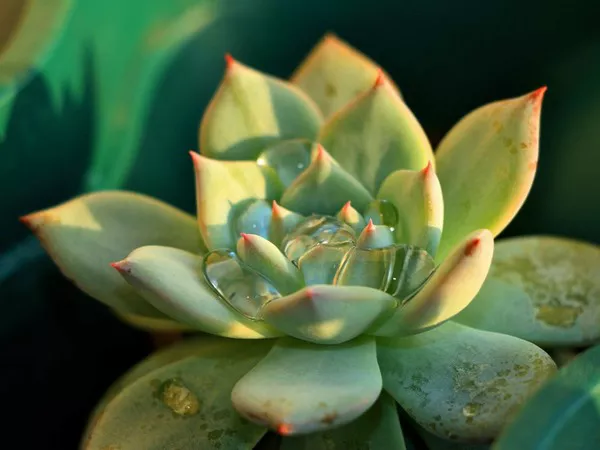Succulents, with their diverse forms and captivating beauty, have become a popular choice for both indoor and outdoor gardens. These resilient plants come in various shapes and sizes, making them an attractive option for any gardener. But how big do succulents grow?
The Influence of Species
The growth of succulents is heavily influenced by their species. Succulents belong to a wide range of plant families, including Crassulaceae, Echeveria, and Aloe, among others. Each species has its unique characteristics and growth patterns. Understanding the specific succulent species you’re dealing with is crucial in gauging how large it will eventually grow.
For instance, Echeveria, a popular succulent species known for its rosette-shaped leaves, typically remains compact and relatively small, growing to a maximum height of 12 inches (30 cm) and spreading up to 18 inches (45 cm) in diameter. On the other hand, some members of the Agave family can grow much larger, with some species reaching heights of 10 feet (3 meters) or more.
Factors Affecting Size
Several factors influence the size of succulents, making it essential to consider these variables when planning your succulent garden. Here are the primary factors to keep in mind:
Species: As previously mentioned, the species of succulent plays a pivotal role in determining its ultimate size. Research the specific species you have to get a better understanding of its growth potential.
Growing Conditions: Environmental factors such as light, temperature, and humidity significantly affect succulent growth. Succulents that receive more sunlight tend to grow more compactly, while those in low-light conditions may become leggy as they stretch towards the light source.
Container Size: The size of the container you plant your succulents in can restrict or encourage their growth. Smaller pots limit their expansion, while larger containers provide more space for them to spread out.
Soil Type: Well-draining soil is essential for succulents. The type of soil you use can impact their growth. Soil that retains too much moisture can lead to root rot, while soil that drains too quickly may require more frequent watering.
Watering Practices: Overwatering can lead to root rot and hinder growth, while underwatering can cause succulents to shrink and become stunted. Finding the right balance is crucial.
Range of Sizes
Succulents exhibit a wide range of sizes, from tiny miniature varieties to massive, tree-like specimens. Here’s a breakdown of the different size categories you can expect to find within the succulent world:
Miniature Succulents: These tiny succulents are perfect for terrariums and small container gardens. Examples include Haworthia cooperi and Sedum pachyphyllum, which typically stay under 3 inches (7.5 cm) in height.
Small to Medium-Sized Succulents: Many popular succulents fall into this category, such as Echeveria, Crassula ovata (Jade Plant), and Aloe vera. They generally range from 6 to 12 inches (15 to 30 cm) in height and spread.
Large Succulents: Some succulents, like Agave americana and Agave americana var. medio-picta ‘Alba’, can grow into large, imposing plants, reaching heights of 6 to 10 feet (1.8 to 3 meters) with a similar spread.
Giant Succulents: In the succulent world, “giants” can reach towering heights of over 10 feet (3 meters). The Agave americana ‘Blue Giant’ and Yucca elephantipes (Spineless Yucca) are examples of such colossal succulents.
Managing Succulent Growth
Whether you’re aiming for compact arrangements or allowing your succulents to grow into impressive specimens, proper care is essential. Here are some tips for managing succulent growth:
Pruning: Regularly trim and prune your succulents to maintain their desired size and shape. Remove any leggy or dead growth to encourage compactness.
Repotting: If your succulent has outgrown its current container, consider repotting it into a larger pot with well-draining soil. This provides more space for root growth and can promote healthier growth overall.
Light Management: Place your succulents in an area that provides the appropriate amount of sunlight for their specific species. Rotating them periodically ensures even growth.
Water Wisely: Follow a consistent watering schedule, allowing the soil to dry out completely between waterings. Adjust your watering frequency based on the season and environmental conditions.
Fertilization: Fertilize sparingly during the growing season to provide essential nutrients. Use a balanced, diluted succulent fertilizer to avoid overfeeding.
Conclusion
Succulents, with their diverse array of sizes and forms, offer a world of possibilities for gardeners and plant enthusiasts alike. Understanding how big succulents grow involves considering factors such as species, growing conditions, container size, soil type, and watering practices. With this knowledge, you can create a succulent garden that showcases the incredible range of sizes these plants can achieve while providing them with the care they need to thrive. Whether you prefer petite succulents or towering giants, succulent gardening offers endless opportunities for creativity and appreciation of nature’s wonders.


